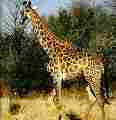
giraffes
Wild Animals
alligators
baboons
bears
chimpanzees
crocodiles
deer
dolphins
elephants
foxes
giraffes
gorillas
leopards
lions
seals
sharks
snakes
tigers
whales
wolves
zebras
Pets
dogs
cats
fish
birds
|
This site provides you with the information about giraffe, giraffe information online, giraffe pictures online, giraffe photos, giraffe pics for kids, images of giraffes, giraffe description, free giraffe info, and more.
If you think that this site is helpful, please recommend your friends to visit our site.
giraffes
Physical Characteristics
The Giraffe has rectangular brown spots outlined with a cream color. Their spotted coat camouflages them among the trees. A giraffe's neck is very long; this helps the giraffespot predators and allows them to feed among tree tops. The giraffe, like most mammals,has only seven neck vertebrae, which are greatly elongated to support its extremely longand muscular neck. They are very tall animals and a male giraffe can reach as high as 19 feet. The male is slightly larger than the female in both height and weight. Giraffes havea long, tough, prehensile tongue and upper lip to pull leaves from branches. This animalalso has a pair of short, bony horns covered with skin and hair on the top of the head such as other animals except giraffes have horns in both sexes. They also have special muscles that can open and close the nostrils and long eyelashes to help protect their eyes from any dust particles and the wind. A giraffe also has a keen sense of smell and hearing and an outstanding sense of sight, which due to their height makes them the most vigilant of the African big-game species. If a giraffe spots a predator and runs they have long legs and hooves that help them in running. Their front legs are placed between the hind legs. Which prevents them from tripping over their own legs. When walking, both right legs move together then the left. Giraffes have an extra strong and large heart that pumps blood to the brain but is actually 2-3 times stronger than a human's heart.
Habitat and Daily Life
Giraffes tend to live in dry, open wooded areas in the savanna. They are grass-eating herbivores and feed mainly on leaves and buds of acacia trees. They also feed on mimosa and wild apricot trees. Giraffes feed with the zebra and antelope which are other herbivores. Giraffes do not have to migrate during dry seasons because they get most their food and moisture from leaves. Giraffes rarely vocalize but when they do it sounds like a moan or a low note. Giraffes sleep standing up. They live in herds of females, young and one adult male. There is a rank order within the herd. The females of the herd
are the most alert to danger. The giraffes protect themselves by kicking their large heavy hooves. Their most threatening predator is the lion.
Reproduction and Cubs
Mating is non-seasonal. When it comes time to mate males attract females by butting with their heavy necks and heads. After a period of 14-15 months a single calf is born. The calf is born 6 feet tall and weighing 100-150 lb. Calves are able to follow their mother 1 hour after birth. Mother defends the calf from predators with vigor. Calves will leave the herd and their mother when they have reached sexual maturity between the age of 3-5 years.




|